 To enhance service speed and avoid tariff delays, we've opened a US warehouse. All US orders ship directly from our US facility.
To enhance service speed and avoid tariff delays, we've opened a US warehouse. All US orders ship directly from our US facility.
| Cat. No. | Product Name | Field of Application | Chemical Structure |
|---|---|---|---|
| DC20158 | 2'-Deoxyadenosine monohydrate Featured |
2'-Deoxyadenosine monohydrate is a deoxyribonucleoside. A building block in the chemical synthesis.
More description
|

|
| DC20144 | 2-Furoic acid Featured |
2-Furoic acid (Furan-2-carboxylic acid) is an organic compound produced through furfural oxidation. 2-Furoic acid exhibits hypolipidemic effet, lowers both serum cholesterol and serum triglyceride levels in rats.
More description
|

|
| DC20137 | 2'-Hydroxy-4'-methylacetophenone Featured |
2'-Hydroxy-4'-methylacetophenone, a phenolic compound isolated from Angelicae koreana roots possesses acaricidal property. It could be used in the preparation of 4’-methyl-2’-[(p-tolylsulfonyl) oxy] acetophenone.
More description
|

|
| DC20134 | 2-Phenylethanol Featured |
2-Phenylethanol (Phenethyl alcohol), extracted from rose, carnation, hyacinth, Aleppo pine, orange blossom and other organisms, is a colourless liquid that is slightly soluble in water. It has a pleasant floral odor and also an autoantibiotic produced by
More description
|
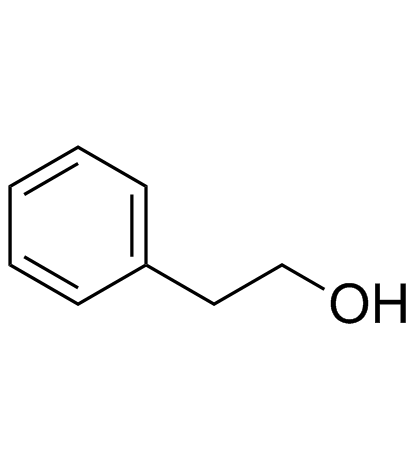
|
| DC20128 | 3,4-Dimethoxycinnamic acid (O-Methylferulic acid) Featured |
3,4-Dimethoxycinnamic acid (O-Methylferulic acid) is a monomer extracted and purified from Securidaca inappendiculata Hassk. 3,4-Dimethoxycinnamic acid exerts anti-apoptotic effects on L-02 cells via the ROS-mediated signaling pathway. Anti-apoptotic effe
More description
|

|
| DC22519 | Norverapamil hydrochloride Featured |
Norverapamil HCl is a calcium channel blocker. It is the main active metabolite of verapamil.
More description
|
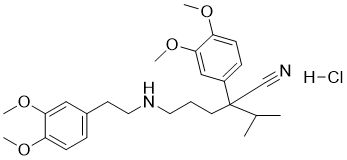
|
| DC22489 | Acebutolol hydrochloride Featured |
Acebutolol HCl is a cardioselective beta-adrenergic antagonist with little effect on the bronchial receptors. The drug has stabilizing and quinidine-like effects on cardiac rhythm as well as weak inherent sympathomimetic action.
More description
|

|
| DC24086 | Azimilide Featured |
Azimilide(NE-10064) is a class III antiarrhythmic compound, inhibits I(Ks) and I(Kr) in guinea-pig cardiac myocytes and I(Ks) (minK) channels expressed in Xenopus oocytes.
More description
|

|
| DC22515 | Trans-ACPD Featured |
trans-ACPD is a selective agonist for metabotropic glutamate receptors, acting at both group I and group II mGlu receptors.
More description
|

|
| DC22490 | 3-Bromopyruvic acid Featured |
A glycolytic inhibitor that inhibits hexokinase II activity, suppresses ATP production, and induces endoplasmic reticulum (ER) stress.
More description
|

|
| DC22527 | Cyclic somatostatin Featured |
A growth hormone-release inhibiting factor used in the treatment of severe, acute hemorrhages of gastroduodenal ulcers.
More description
|
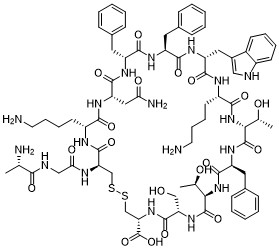
|
| DC24089 | KX2-391 mesylate Featured |
A highly selective, non-ATP competitive substrate-pocket-directed Src/pretubulin inhibitor.
More description
|

|
| DC24087 | Calcipotriol monohydrate Featured |
A hormonally active metabolite of vitamin D that binds to vitamin D receptor (VDR).
More description
|

|
| DC24056 | Agomelatine hydrochloride Featured |
A melatonin receptor agonist of MT1 (Ki=0.1nM) and MT2 (Ki=0.12nM), and a 5-HT2C (Ki=631nM) receptor antagonist.
More description
|

|
| DC24055 | Agomelatine L(+)-Tartaric acid Featured |
A melatonin receptor agonist of MT1 (Ki=0.1nM) and MT2 (Ki=0.12nM), and a 5-HT2C (Ki=631nM) receptor antagonist.
More description
|

|
| DC23973 | F16 Featured |
A mitochondriotoxic small molecule that selectively inhibits proliferation of mammary epithelial, neu-overexpressing cells, as well as a variety of mouse mammary tumor and human breast cancer cell lines.
More description
|

|
| DC23907 | Polyoxyethylene 40 stearate Featured |
A non-ionic emulsifying agent that can modulate multidrug resistance and enhances antitumor activity of vinblastine sulfate by modulating substrate-stimulated P-gp ATPase activity.
More description
|

|
| DC24049 | Anamorelin fumarate Featured |
A non-peptide, centrally-penetrant and selective agonist of GHSR with appetite-enhancing and anabolic effects.
More description
|
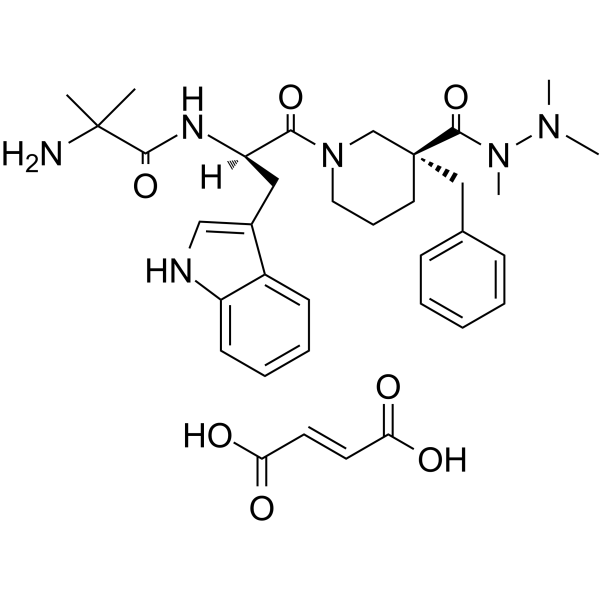
|
| DC22487 | Benzenepentacarboxylic Acid Featured |
Benzenepentacarboxylic acid is a fluorescent dye that detects and scavenge HO radicals.
More description
|

|
| DC23940 | NM107 Featured |
NM-107, also known as 2'-C-Methylcytidine; 2'-C-MeC; 2-CMC; mCyd ; 2'CMeC; 2CMC, is a a potent and selective anti-viral drug. NM-107 showed activity to inhibit the replication of foot-and-mouth disease virus. NM-107 exerts potent anti-DENV activity in DENV subgenomic RNA replicon and infectious systems, with an IC50 value of 11.2±0.3μM. NM-107 may be a promising compound for the development of direct-acting antivirals against DENV infection.
More description
|

|
| DC23952 | GR-79236 Featured |
GR79236 is a highly potent and selective adenosine A1 receptor agonist (Ki = 3.1 nM) that has analgesic and anti-inflammatory actions in humans and animals.
More description
|
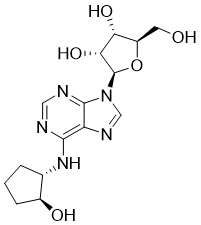
|
| DC24091 | TH-287 hydrochloride Featured |
TH287 hydrochloride is a potent and selective inhibitor of MTH1, with an IC50 of 0.8 nM. TH287 hydrochloride is highly selective towards MTH1, with no relevant inhibition of MTH2, NUDT5, NUDT12, NUDT14, NUDT16, dCTPase, dUTPase and ITPA at 100 μM. TH287 hydrochloride could act as a chemotherapeutic agent for cancer research.
More description
|
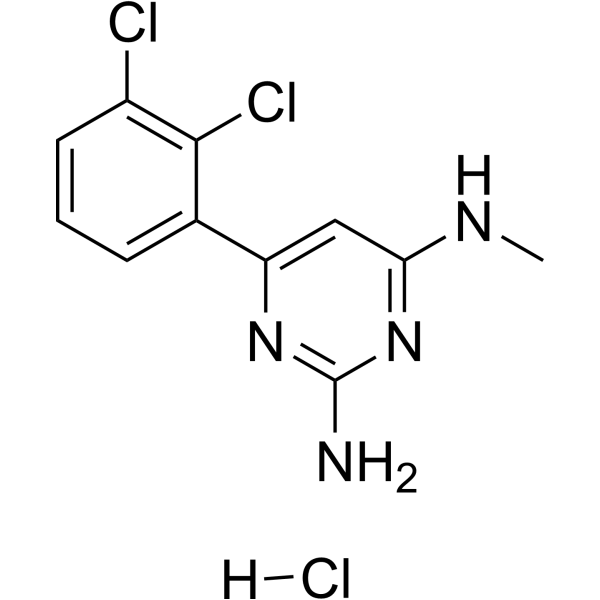
|
| DC24066 | CYT387 mesylate Featured |
A potent and selective JAK1/JAK2 inhibitor with IC50 of 11/18 nM.
More description
|

|
| DC24067 | CYT387 sulfate salt Featured |
A potent and selective JAK1/JAK2 inhibitor with IC50 of 11/18 nM.
More description
|
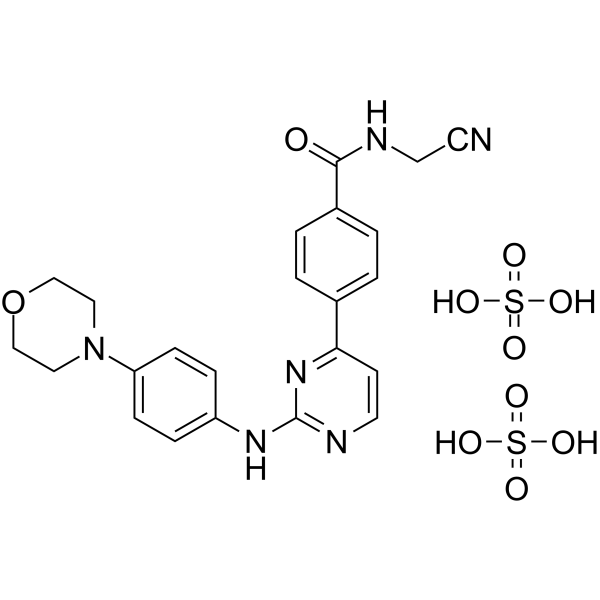
|
| DC23905 | Beaucage reagent Featured |
Beaucage reagent is a DNA cleavage reagent.
More description
|

|
| DC23991 | Daclatasvir Featured |
Daclatasvir is an orally available antiviral agent that inhibits the NS5A region of the hepatitis C virus (HCV) and is used in combination with other oral antiviral agents to treat chronic hepatitis C. Elevations in serum enzyme levels during daclatasvir therapy are uncommon, and it has yet to be convincingly implicated in cases of clinically apparent liver injury with jaundice. Nevertheless, and for unknown reasons, successful all-oral regimens of antiviral therapy in patients with chronic hepatitis C and cirrhosis is occasionally complicated by hepatic decompensation and may cause reactivation of hepatitis B in susceptible patients coinfected with the hepatitis B virus (HBV).
More description
|
.gif)
|
| DC23951 | Cevimeline hydrochloride Featured |
Cevimeline HCl is a cholinergic agonist that binds to muscarinic receptors. Muscarinic agonists in sufficient dosage can increase secretion of exocrine glands, such as salivary and sweat glands, and increase tone of the smooth muscle in the GI and urinary tracts.
More description
|

|
| DC23950 | Cevimeline Featured |
Cevimeline is a parasympathomimetic and muscarinic agonist that affects M1 and M3 receptors. It is used in the treatment of dry mouth and Sjögren's syndrome. Cevimeline has also been shown to reduce Xerostomia symptoms and increase salivary flow in head and neck cancer survivors after radiotherapy.
More description
|

|
| DC23941 | RU-24969 Featured |
A potent, selective agonist of 5-HT1A and 5-HT1B receptors, with preference for 5-HT1B.
More description
|
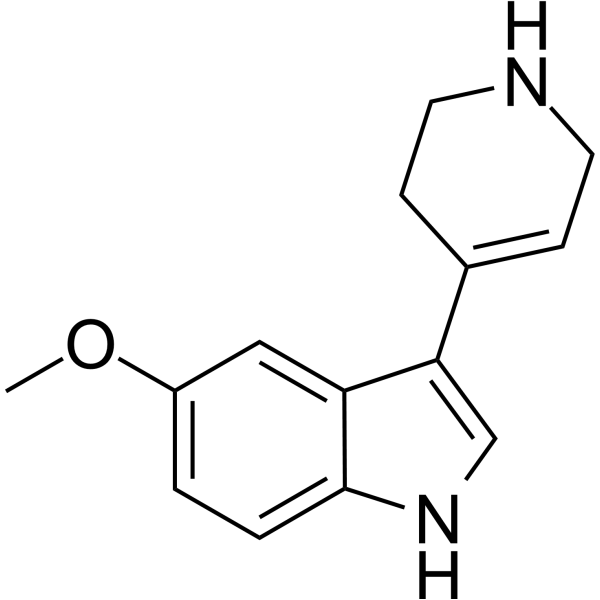
|
| DC24064 | SB-408124 hydrochloride Featured |
A potent, selective OX1 receptor antagonist with Ki of 57 nM (whole cell assay), and 27 nM (cell membrane-based SPA assay).
More description
|
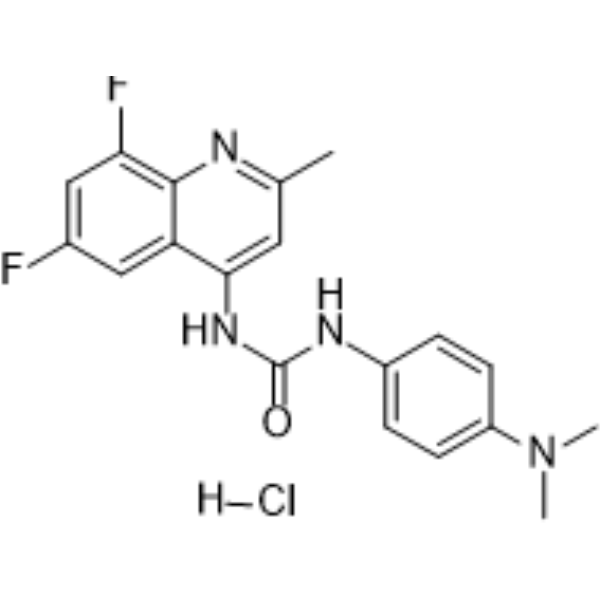
|